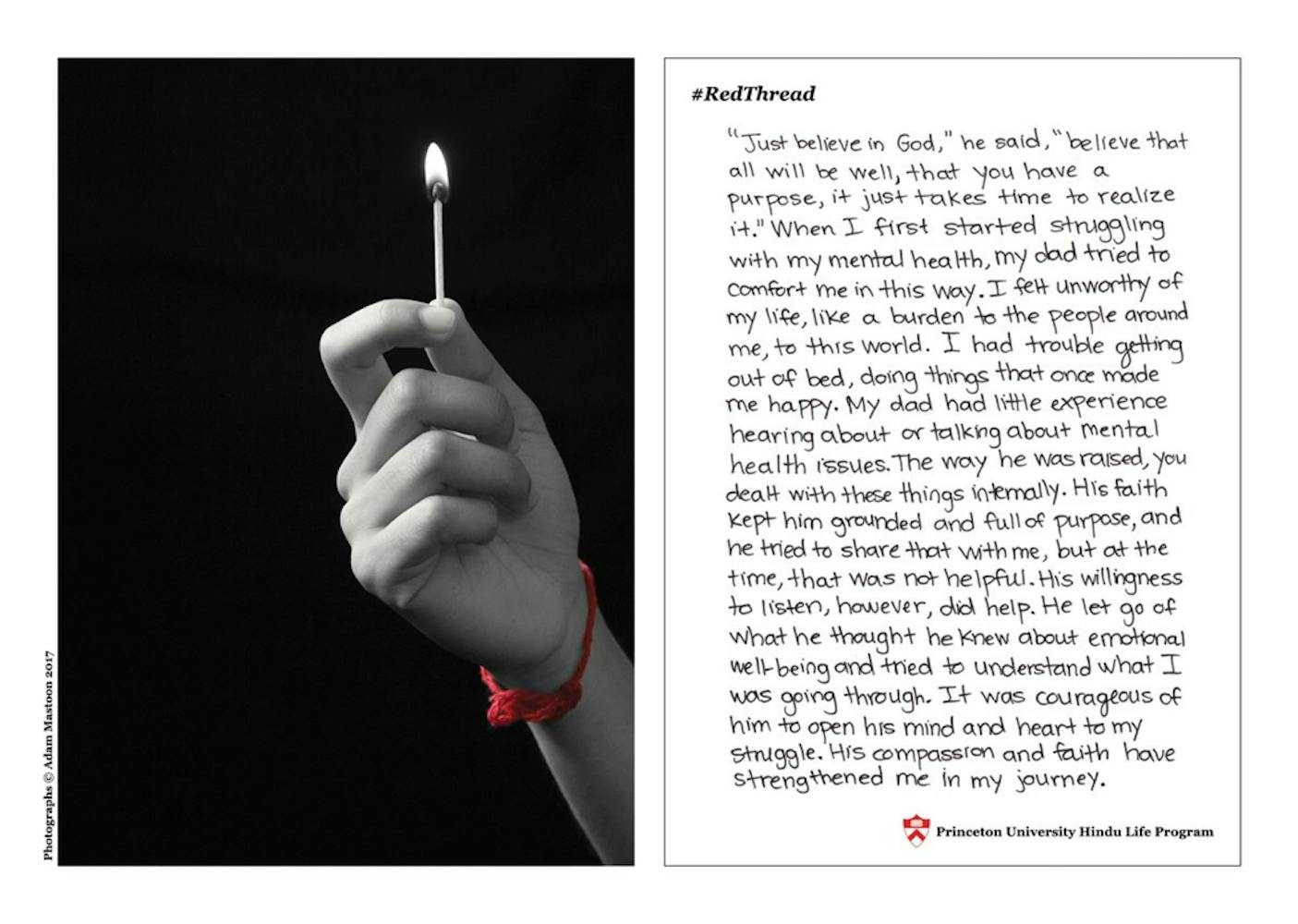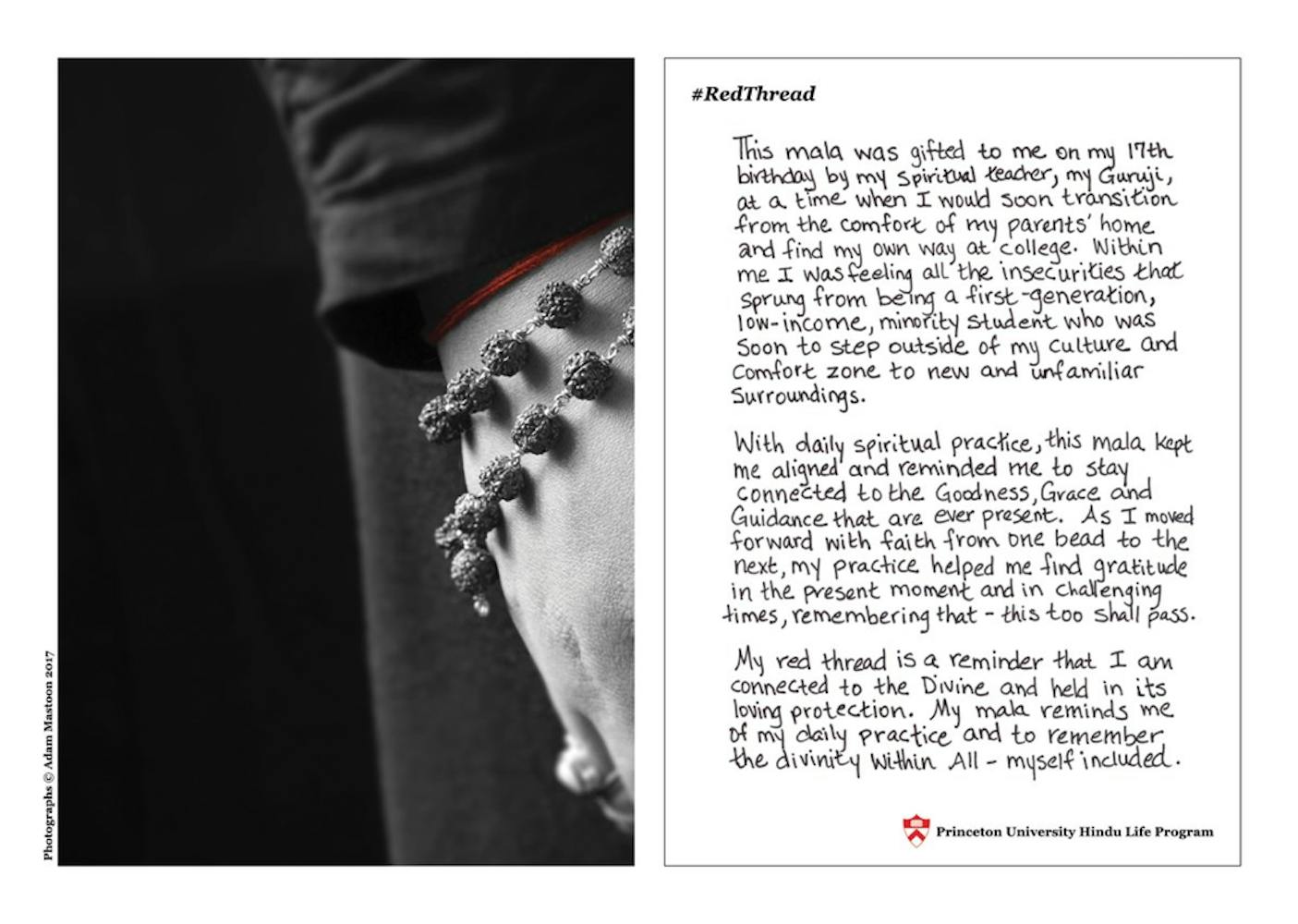“Issues around mental wellness must be destigmatized, pulled out from the shadows of taboo and shame, and brought into the light of day,” said University coordinator for Hindu life Vineet Chander, after the Oct. 10 launch of the #RedThread project, a campaign for mental health awareness in the South Asian community.
The campaign, launched by the Hindu Life Program, aims to promote awareness and solidarity within the University community in order to bring to light mental wellness issues faced by South Asians.
“Some of the most prevalent concerns I've seen in this community are around anxiety, depression, managing expectations and pressure, sexuality and sexual identity, body image, eating disorders, and abusive or toxic relationships,” explained Chander.
The campaign consists of photographs of University students, faculty, and staff members, accompanied by handwritten stories that reflect mental wellness issues within the South Asian community. Acclaimed photographer and activist Adam Mastoon created the artwork for the exhibit, which is currently being exhibited in the basement of East Pyne, near Chancellor Green Cafe. Visitors to the exhibit can take home with them postcards displaying the photographs and stories.
Artist-activist Adam Mastoon spoke about the significance of incorporating art into the campaign.
“As an artist, my work is based in the desire to create human dialogue, by allowing people an opportunity to tell their stories,” he said. “Art has a way of opening our minds and our hearts in a way that is very unique. In a topic like this, that is so personal and vulnerable, to approach it from an artistic vantage point allows an extra sense of humanness.”
“What photography does so beautifully is reflect back to us the humanity of people and of the world,” he continued. “And what was needed most for this project was that humanity.”
Mastoon also expressed his belief that mental and emotional well-being are essential for functioning, especially in educational communities.

“Everyone involved was incredibly sensitive, thoughtful and had a real desire to reach out in order to bring wholeness to the community, and that really touched me," he said.
“Our hope was that by sharing our images and stories, we could re-vision the community as a haven of support and understanding, rather than a source of judgment, fear, or shame,” Chander said.
One postcard is from an individual struggling with depression. “I discovered those two words of comfort in the Bhagavad Gita, ‘Fear Not,’ and tattooed them on myself to remind me,” the postcard reads. “Today, I look at my wrist and I remember the promise of love and Grace that my Beloved whispers to me.”
Another postcard describes the individual’s unique perspective on dating and marriage. “I love my family, but sometimes I feel that my parents and I are living in diametrically opposed cultures,” it reads. “I just hope that someday I find ‘the one’ who will make me happy, and also be the ‘right category’ for my parents.”

Visitors are also encouraged to take a red thread and tie it around their wrist as an act of solidarity with mental health struggles. “Thread binds us together. The idea is that the red thread around my wrist is cut from the same spool as the one around yours,” said Chander. “We are thus connected, even as we are unique individuals with our own stories and struggles.”
According to Chander, the red thread was chosen to be the focus because of its recognizability and significance in Hindu culture. “The red thread serves as a symbol of divine protection,” he noted. “It also sanctifies the body for ritual worship, symbolizing purity and intention, and serves as a reminder of one's place in the cosmos.”
Chander said that as the Hindu chaplain on campus, addressing mental health concerns has always been on his mind. “A big part of chaplaincy is offering pastoral counseling, and as I did this and got to know students better in this context, I began to see themes emerge that I felt were linked to mental wellness,” he explained.
Mental health concerns in the South Asian community are complicated by the secrecy and shame which oftentimes surround them, Chander continued. This stigma discourages students from seeking help.
“Tragically, this isolation can often compound the challenges themselves,” added Chander.
Arjun Venkataraman '18, president of the Princeton Hindu Satsangam, expressed similar ideas. “In the South Asian community, there is a stigma associated with discussing negative mental health,” he said. “A campaign like #RedThread allows those who are struggling to see that they are not alone. It provides a sense of companionship on their journey that is often not found in their community.”
Mashad Arora '20, another Princeton Hindu Satsangam member, explained that he thinks mental health is an issue not properly addressed in the South Asian community. “Sometimes being open about how you feel is the most important thing, and I think this campaign is a good way to start dialogue about mental health among South Asians, Arora added.
Arora is a former staff writer for the 'Prince.'
According to Chander, he's grateful that the project has received a tremendous positive response.
“I've heard back from students, faculty members, community members, even docents and folks affiliated with the [University] Art Museum, and everyone has remarked upon how moved and struck they are by walking through the exhibit or encountering it online via social media,” he said. “Moreover, I've found people on campus, South Asians, but also non-South Asians, telling me how much they see themselves and their own experiences and struggles in the stories and portraits.”
The Office of Religious Life is also using #RedThread to run a social media campaign on Facebook, Twitter and Instagram. A different photo and story from the exhibit is posted each day.
This story has been updated to include comment from Adam Mastoon.









